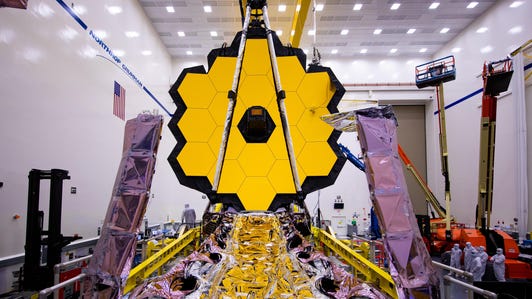
Another day, another mind-blowing view of the cosmos from the James Webb Space Telescope. The latest entry in Webb's run of jaw-dropping images shows how the next-generation observatory is able to reveal exquisite details of the Tarantula Nebula, a scenic region of gas, dust and hot young stars.
JWST sees the universe in infrared light, letting it peer deep into space objects. The Tarantula Nebula images are an excellent example of this. "A range of Webb's high-resolution infrared instruments, working together, reveal the stars, structure, and composition of the nebula with a level of detail not previously possible," NASA said in a statement on Tuesday.
The nebula's formal name is 30 Doradus, but its spindly "legs" of dust and gas filaments (notably seen in this Hubble view) earned it the spidery nickname. The nebula -- located 161,000 light-years away in the Large Magellanic Cloud galaxy -- is a fiesta of star formation, home to thousands of up-and-coming stars that are among the hottest and most massive ones we've ever seen.
Webb's Near-Infrared Spectrograph (NIRSpec) took a look at what appeared to be a bubble in the nebula, but found a young star still cocooned by a cloud of gas. It's a portrait of "star birth in action."
NASA, ESA, CSA, STScI, Webb ERO Production TeamWebb's Near-Infrared Camera (NIRCam) sees the nebula as "a burrowing tarantula's home, lined with its silk." Look to the center of the NIRCam image to see blue stars twinkling in a cavity they've created from their own radiation. "Only the densest surrounding areas of the nebula resist erosion by these stars' powerful stellar winds, forming pillars that appear to point back toward the cluster," said NASA. Those pillars are dotted with protostars in an early stage of formation.
The telescope's Near-Infrared Spectrograph (NIRSpec) got up close and personal with one of the stars in the nebula. It was an eye-opener because researchers originally suspected the star was a little older and was clearing out a bubble around itself like those central stars had done. "However, NIRSpec showed that the star was only just beginning to emerge from its pillar and still maintained an insulating cloud of dust around itself," NASA said.
The observatory's Mid-infrared Instrument (MIRI) sees in longer wavelengths of infrared, so it brings a different perspective to the star party. The MIRI image zooms in on the nebula's central star cluster. "The hot stars fade, and the cooler gas and dust glow," NASA said. "Within the stellar nursery clouds, points of light indicate embedded protostars, still gaining mass."
Webb's MIRI instrument highlights gas, dust and protostars.
NASA, ESA, CSA, STScI, Webb ERO Production TeamAstronomers have been pumped for Webb's observations of the Tarantula Nebula for what it will reveal about star formation and for how the nebula's activities will compare with future Webb observations of galaxies from the early universe.
Webb -- a joint project from NASA, the European Space Agency and the Canadian Space Agency -- has been delivering gorgeous views of the cosmos and fresh science discoveries since going into full operation earlier this year. "Webb has already begun revealing a universe never seen before," NASA said, "and is only getting started on rewriting the stellar creation story."









 Add Category
Add Category



